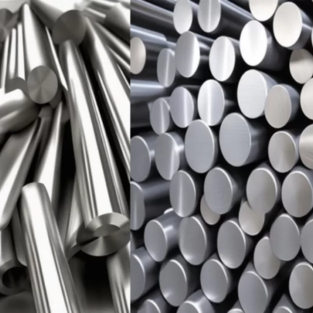

Stainless steel types 1.4301 and 1.4307 are commonly called grades 304 and 304L. Type 304 stainless steel is very versatile and widely used. Sometimes, people still call it by its old name, 18/8. This name comes from the composition of type 304, which has 18% chromium and 8% nickel. The essential properties of stainless steel include the amount of nickel and chromium, workability, hardness, yield strength, and corrosion resistance. Stainless steel must maintain these properties consistently, regardless of temperature, without causing any harm to machinery. We will discuss each of them in detail, explaining their uses and applications.
What is 304 Stainless Steel?
Stainless steel is a type of metal that doesn’t easily rust or stain. 304 is a type of stainless steel that is good for deep drawing. The popularity of grade 304 has made it the most commonly used grade for sinks and saucepans. 304 stainless steel comprises 18% chromium and 8% nickel. It also contains other elements like nickel, manganese, silicon, nitrogen, carbon, phosphorus, and sulfur, which help improve its quality as stainless steel. 304 Stainless Steel is a versatile material that can be easily shaped into complex structures. It makes it useful in various industries, such as manufacturing, construction, and sanitaryware. 304 stainless steel alloys are commonly used in welding industries because they can be readily welded without compromising corrosion resistance or adding significant weight. They make them popular for metal sheeting, wire mesh products, and steam piping applications.
3 Main Types of 304 Stainless Steel Grades:
304L Stainless Steel
Stainless steel 304L is a version of stainless steel 304 with low carbon content. It is used in heavy-duty parts to make welding easier. Certain products, like plates and pipes, can be found as “dual certified” materials. It means they meet the requirements for both 304 and 304L. 304L can still be used in various industries. It is often preferred over other stainless steel grades because it is easier to weld. It does this by reducing the formation of carbide deposits, even in highly corrosive environments.
304L Stainless Steel Chemical Composition (in %)
| Carbon | 0.03 Max |
| Chromium | 18.00-20.00 |
| Iron | Makes up the Balance |
| Manganese | 2.00 Max |
| Nickel | 8.00-12.00 |
| Nitrogen | 8.00-12.00 |
| Phosphorus | 0.045 Max |
| Silicon | 0.75 Max |
| Sulphur | 0.030 Max |
304H Stainless Steel:
The “H” in 304H stands for “High” carbon content. It means it has more carbon, which makes it more robust and better at handling high temperatures. 304H stainless steel is a good choice for high-temperature uses. It is strong and can handle temperatures ranging from 550°C to 800°C. Stainless Steel 304H has good oxidation resistance. It means it can be used periodically at temperatures up to 870°C and continuously at temperatures up to 925°C.
304H Stainless Steel Chemical Composition (in %):
| Chromium | 18.0 min.-20.0 max. |
| Nickel | 8.0 min.-10.5 max. |
| Carbon | 0.04 min-0.10 max. |
| Manganese | 2.00 |
| Phosphorus | 0.045 |
| Sulphur | 0.030 |
| Silicon | 0.75 |
304LN Stainless Steel:
304LN stainless steel is a variation of the 304 grade. 304LN is a type of stainless steel that has been enhanced with nitrogen. It belongs to the austenitic grade. It increases strength without reducing flexibility. This grade can easily handle high temperatures ranging from 1000°C to 1100°C. It is more stable than 304L regarding martensitic transformations at low temperatures.
304LN Stainless Steel Chemical Composition (in %):
| Chromium | 18-20 |
| Nickel | 8-12 |
| Manganese | 2 max |
| Silicon | 1 max |
| Nitrogen | 0.1-0.16 |
| Phosphorous | 0.045 max |
| Carbon | 0.03 max |
| Sulphur | 0.03 max |
| Iron | Remainder |
304 Stainless Steel Corrosion Resistance
304 Stainless steel has excellent corrosion resistance in various environments and when in contact with different corrosive media. Pitting and crevice corrosion can occur in environments containing chlorides. Stress corrosion cracking can occur at temperatures over 60°C. Thermal treatments cannot readily harden stainless steel 304 but can easily be annealed, which increases its workability and AISI 304 stainless steel yield strength.
304 Stainless Steel Heat Resistance
304 Stainless steel can withstand oxidation at temperatures up to 870°C when used occasionally and up to 925°C when used continuously. Using it continuously at temperatures between 425-860°C is not recommended if you want it to resist corrosion in water. It is best to use 304L because it does not experience carbide precipitation. Using stainless steel grade 304H is recommended to process materials at high temperatures for long periods. If you’re looking for a material that stays strong even at temperatures ranging from 500°C to 800°C, it’s best to use 304H stainless steel.
304 Stainless Steel Machinability:
304 Stainless steel is easy to machine. To improve machining, follow these rules:
It is important to keep cutting edges sharp. Dull edges make work hardening worse.
Make sure to make light cuts that are deep enough to avoid work hardening. It means cutting on the surface of the material.
Use chip breakers to help keep the work area free of swarf.
Austenitic alloys have low thermal conductivity, so heat builds up at the cutting edges. Coolants and lubricants are essential and should be used in large amounts.
304 Stainless Steel Hot Working:
When using hot working methods like forging, it is essential to heat the material uniformly to a temperature between 1149-1260°C. To ensure the fabricated components are highly resistant to corrosion, they should be cooled down quickly. Using high temperatures regularly, especially with moisture, is not recommended.
304 Stainless Steel Fabrication:
When working with stainless steel, using tools specifically designed for stainless steel materials is essential. Before using tooling and work surfaces, it is necessary to clean them thoroughly. It prevents corrosion, and it is crucial to take precautions. When working with stainless steel, using materials specifically designed for stainless steel fabrication is essential. Additionally, cleaning the materials before using them in the fabrication process is critical.
304 Stainless Steel Cold Working:
Stainless steel 304 can quickly become harder when worked on. When using cold working methods on fabrications, including a step called annealing may be necessary. This step helps to reduce the hardness caused by the work and prevents tearing or cracking. After completing the stainless steel fabrication process, it is essential to perform an annealing process. This process helps to reduce internal stresses and improve corrosion resistance.
304 Stainless Steel Heat Treatment:
Heat treatment cannot make 304 stainless steel hard. To perform solution treatment or annealing, heat the material to a temperature between 1010-1120°C and cool it quickly.
304 Stainless Steel Welding:
304 stainless steel has good welding performance, whether with or without fillers. For 304 stainless steel, it is recommended to use grade 308 stainless steel filler rods and electrodes. The recommended filler for 304L is 308L. Large welded parts may need to be annealed after welding. You don’t need to do this step for 304L. Grade 321 can be used when post-weld heat treatment is not possible.
304 Stainless Steel Applications:
304 Stainless steel is typically used in:
- Springs, nuts, bolts and screws
- Offshore Technology
- Seawater Desalination Plants
- Chemical Industry
- Bridges
- Storage Tanks
- Medical Industry
- Civil Engineering
- Power Plants
- Shipbuilding Industry
- Sinks and splashbacks
- Automotive and aerospace components
- Fasteners and flange manufacturing

